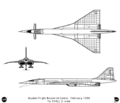Tupolev Tu-144 facts for kids
The Tupolev Tu-144 was an amazing airliner from the USSR. It was special because it was the very first passenger plane to fly faster than the speed of sound! This means it could travel quicker than any sound you hear. Built by a company called Tupolev, it looked quite a lot like another famous supersonic plane, the Concorde. Because of this, some people even called it "Concordski"! The Tu-144 flew only for Aeroflot, which was the main airline in the Soviet Union. Only sixteen of these incredible planes were ever built. Its very first flight was on December 31, 1968.
Contents
What Made the Tu-144 Special?
The Tu-144 was designed to fly at amazing speeds, much faster than regular airplanes. It could reach speeds of over 2,000 kilometers per hour (about 1,240 miles per hour)! To do this, it had some unique features:
- Delta Wings: Its wings were shaped like a triangle, which is great for flying fast.
- Droop Nose: The front part of the plane, called the nose, could tilt downwards during takeoff and landing. This helped the pilots see the runway better.
- Moustache Canards: It also had small, retractable wings near the front, often called "moustache canards." These helped the plane control itself at slower speeds, especially during takeoff and landing.
Early Flights and Passenger Service
The Tu-144 made its first flight on December 31, 1968, just a couple of months before the Concorde. This made it the first supersonic passenger jet to fly. After many test flights, it began carrying mail and cargo in 1975. Then, on November 1, 1977, it started flying passengers! Its main route was between Moscow and Almaty, a city in what is now Kazakhstan. Flying at supersonic speeds meant the journey was much faster than on a regular plane.
The Paris Air Show Incident
Sadly, a major event happened that affected the Tu-144's future. On June 3, 1973, one of the Tu-144 planes crashed during a flight display at the Paris Air Show in France. This was a very sad day and led to many questions about the plane's safety. While the exact cause was debated, the accident made people worried about supersonic travel.
Why the Tu-144 Stopped Flying
After the Paris Air Show crash, the Tu-144's passenger flights were very limited. Another incident in 1978 also contributed to its grounding. The Soviet government decided to stop regular passenger flights with the Tu-144 in 1978. There were several reasons for this decision:
- Safety Concerns: The crashes raised serious safety questions.
- High Costs: Supersonic planes use a lot of fuel, making them very expensive to operate.
- Noise: Supersonic flights create a loud "sonic boom" when they break the sound barrier, which was a problem for people on the ground.
Even though it stopped passenger service, some Tu-144s were still used for research and testing for many years.
The Tu-144 and NASA
In the 1990s, after the Soviet Union ended, one of the Tu-144 planes got a new life! It was modified and used by the American space agency, NASA, along with Russian companies. This special version was called the Tu-144LL, where "LL" stood for "Flying Laboratory." NASA used it to study supersonic flight and gather information for future high-speed aircraft designs. This showed that even after its passenger career ended, the Tu-144 was still valuable for scientific research.
Where Are They Now?
Today, you can find several Tu-144 aircraft preserved in museums. They are important pieces of aviation history, showing how engineers pushed the limits of flight. You can see them in places like the Central Air Force Museum in Monino, Russia, and the Auto & Technik Museum Sinsheim in Germany. These museums allow people to see these impressive planes up close and learn about their story.
Images for kids
-
Aeroflot Tu-144 at the Paris Air Show in 1975.
-
The first production Tu-144S displaying at the 1973 Paris Air Show on the day before it crashed. The aircraft's planform and canards are clearly shown.
-
The Tu-144LL used by NASA to carry out research for the High Speed Civil Transport
See also
 In Spanish: Túpolev Tu-144 para niños
In Spanish: Túpolev Tu-144 para niños











